

Knowledge Economy - The Four Pillars of The Knowledge Economy. The following pillars are four critical requisites for a country to be able to fully participate in the knowledge economy: Education & Training An educated and skilled population is needed to create, share and use knowledge.
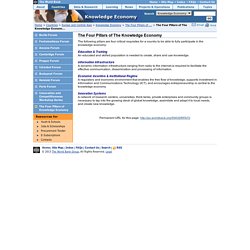
Information Infrastructure A dynamic information infrastructure-ranging from radio to the internet-is required to facilitate the effective communication, dissemination and processing of information. Introduction to AI. Richard Seel, January 2008 For a Word version, click here.
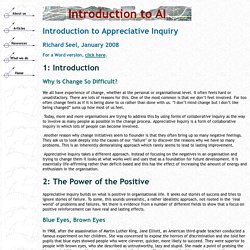
Why is Change So Difficult? We all have experience of change, whether at the personal or organisational level. It often feels hard or unsatisfactory. There are lots of reasons for this. Today, more and more organisations are trying to address this by using forms of collaborative inquiry as the way to involve as many people as possible in the change process. Another reason why change initiatives seem to flounder is that they often bring up so many negative feelings. Appreciative Inquiry takes a different approach. Appreciative Inquiry builds on what is positive in organisational life. Blue Eyes, Brown Eyes In 1968, after the assassination of Martin Luther King, Jane Elliott, an American third-grade teacher conducted a famous experiment on her children.
Elliott’s aim had been to give her children an experience of discrimination and show them how artificial it really is. The Placebo Effect The Dynamics of High Performance Teams Discover. Library and knowledge services.
Info and Knowledge audits. Data Management. Best Practices White Papers. The Future of Knowledge Management. Ross DawsonOriginally published in Australian Financial Review In the much vaunted “hype cycle” of business trends and fads, knowledge management has already plumbed the depths of disillusionment.
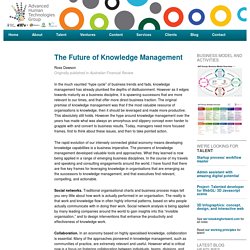
However as it edges towards maturity as a business discipline, it is spawning successors that are more relevant to our times, and that offer more direct business traction. The original premise of knowledge management was that if the most valuable resource of organisations is knowledge, then it should be leveraged and made more productive. This absolutely still holds. However the hype around knowledge management over the years has made what was always an amorphous and slippery concept even harder to grapple with and convert to business results.
The rapid evolution of our intensely connected global economy means developing knowledge capabilities is a business imperative. Social networks. Collaboration. Relevance. Workflow. The Public Sector - Information management in an age of transformation. The challenge Some individuals, teams and departments are able to make their own arrangements for information categorisation, filing, retrieval and retention, with no single person having a complete overview or holding accountability.
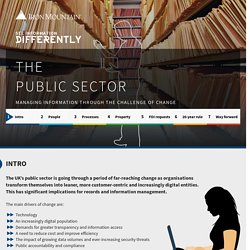
When continuity is lost through staff turnover or departments closing or merging, the result is a lack of ownership and little integration of information. Policies can fail to keep pace with changing work practices, such as flexible, mobile and remote working. Writing a Stategic Management Report. Week One What is Knowledge Tutorial Final 20.01.2016 (1) Hislop: Knowledge Management in Organizations 3e. Knowledge Management, Content Management, SharePoint. What is the difference between data, information and knowledge? The Bread-Making Machine: Tacit Knowledge and Two Types of Action. Peripheral VisionThe Bread-Making Machine: TacitKnowledge and Two Types of Action Rodrigo Ribeiro and Harry Collins Abstract We analyse Nonaka and Takeuchi’s (1995) claim that a master baker’s tacit knowledgewas made explicit and incorporated into a home bread-making machine and its manual— the ‘knowledge capture’thesis.
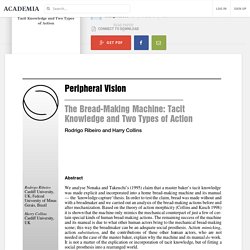
In order to test the claim,bread was made without andwith a breadmaker and we carried out an analysis of the bread-making actions before andafter mechanization. Based on the theory of action morphicity (Collins and Kusch 1998)it is shown that the machine only mimics the mechanical counterpart of just a few of cer-tain special kinds of human bread-making actions. Mimicking ,action substitution ,and the contributions of these other human actors,who are notneeded in the case of the master baker,explain why the machine and its manual do. Knowledge management consultants. Each person is inundated with 174 newspapers' worth of information EVERY DAY. By David Derbyshire for MailOnline Updated: 10:30 GMT, 11 February 2011 From junk emails to annoying adverts, we spend our lives being bombarded with a constant stream of information.
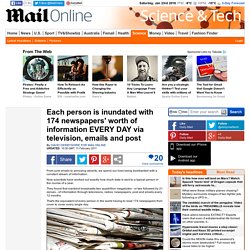
Now scientists have worked out exactly how much data is sent to a typical person in the course of a year. They found that mankind broadcasts two quadrillion megabytes - or two followed by 21 zeroes - of information through televisions, radios, newspapers, post and emails every 12 months. That's the equivalent of every person in the world having to read 174 newspapers from cover to cover every single day. Information overload: Scientists have worked out exactly how much data is sent to a typical person in the course of a year - the equivalent of every person in the world reading 174 newspapers every single day The study also found that the world's libraries, computers, DVD collections and newspapers store a staggering 295trillion megabytes of information - or 295 followed by 18 zeroes. Forbes Welcome. 14 Ways to Present Information Visually. [This is an update of a popular post written by Ryan Skinner a few years back.
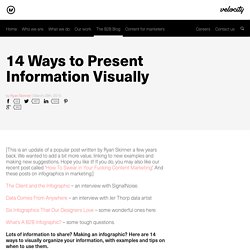
We wanted to add a bit more value, linking to new examples and making new suggestions. Hope you like it! If you do, you may also like our recent post called ‘How To Swear in Your Fucking Content Marketing‘. And these posts on infographics in marketing:] The Client and the Infographic – an interview with SignalNoise. Data Comes From Anywhere – an interview with Jer Thorp data artist Six Infographics That Our Designers Love – some wonderful ones here.